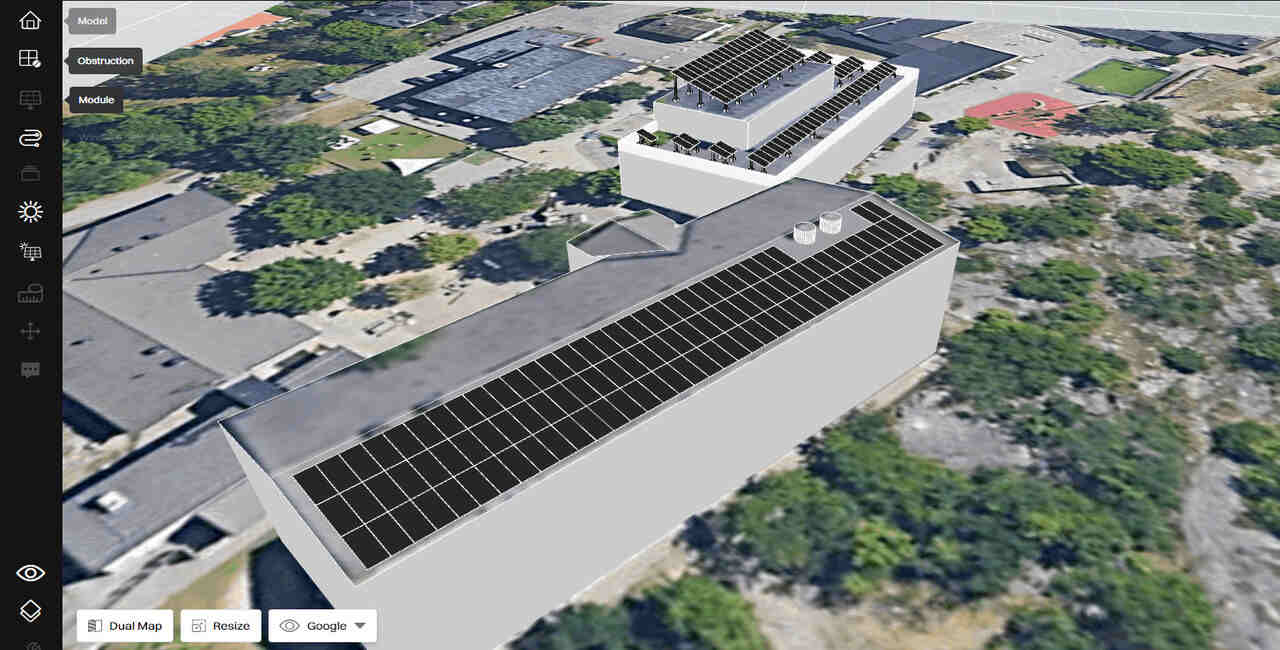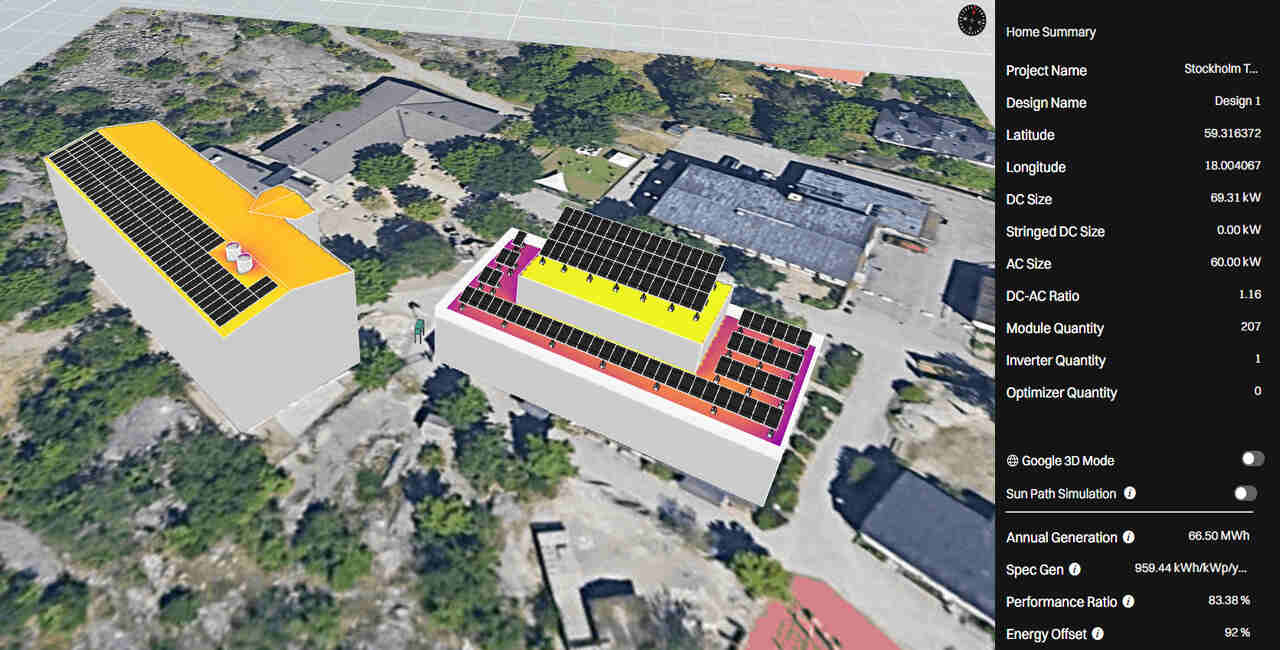Best Solar Rooftop Design Software 2024

Solar Rooftop Design: What Does That Mean?
Rooftop solar panels are great for converting the sun's energy, which would otherwise be squandered, into power. A rooftop solar power system is a photovoltaic (PV) system with electricity-producing solar panels installed on the roof of a home or business building or structure. Photovoltaic modules, mounting systems, cables, solar inverters, and other electrical accessories are among the different components of such a system.
Rooftop-mounted systems are small in comparison to utility-scale solar ground-mounted photovoltaic power plants with megawatt capacity, making them a kind of distributed generation. The majority of rooftop solar power stations are grid-connected photovoltaic power systems. Rooftop PV systems on residential buildings typically have capacities ranging from 5 to 20 kW, whereas those on commercial buildings typically have capacities ranging from 100 kW to 1 Megawatt (MW). Large rooftops may accommodate industrial-sized PV systems ranging from 1 to 10 megawatts.
Solar panel and equipment costs have dropped dramatically in the previous decade, aiding in the mainstreaming of solar energy. Soft expenses, such as customer acquisition, permits, location, design, installation, and finance, have not been reduced as rapidly. Many solar firms are simplifying their processes as the sector grows and matures.
Reducing soft expenses by incorporating technology into fundamental company procedures is a method of maintaining profitability and improving accuracy while lowering overall solar system costs. Customer identification, customer relationship management (CRM), proposal generation, photovoltaic system design, finance and risk management, and operations and energy management are all met by different forms of solar rooftop design software. Increasing automation across the process, from client acquisition through solar PV system maintenance, can assist solar providers in scaling up their operations. Using efficient solar rooftop design software is a great way to supplement that approach.
What Are The Benefits Of Installing Solar Rooftop?
Let us understand in detail why solar rooftop is a good investment:
Cost Savings: One of the most significant advantages of installing solar panels on the roof is the cost savings. Rooftop solar tariffs are estimated to be 17% and 27% less expensive than industrial and commercial tariff rates, respectively.With the trend in solar being that panels are becoming more affordable, companies who choose solar will undoubtedly benefit in the coming years.
Reduces Carbon Footprint: From the installation of the panels to the power supplied by PV cells, there are no health risks or heat-trapping gasses that contribute to global climate change. It not only does not emit carbon dioxide, but it also emits none of the other toxic pollutants or wastes associated with coal, such as nitrogen oxides, sulphur dioxide, and mercury.
Low Maintenance Costs: A rooftop solar system is a low-cost system. It merely has to be cleaned and maintained on a regular basis, which is not a difficult operation. Most solar roofs have a life expectancy of 25 years, making them an excellent investment. As a result, there are no significant expenditures.
Reduction in Electricity Bills: Installing solar panels for home or business usage might help you save money on your power bill. A standard power connection uses coal, oil, and natural gas to power houses around the country. Installing solar panels on your home's rooftop saves you money and helps the environment. Of course, each family is distinct and has various solar panel needs.

No Additional Space Required For Installation: As the system is situated on the rooftops of business or residential buildings, enormous expanses of land are not required; this concept is both feasible and sustainable. This has an added benefit in that the resale value of a property will improve if it has a solar rooftop system installed.
Support from the Government: Solar rooftop installations are exempt from the 5% tax rate. It is the most appealing tax rate offered by the government (if the 0% tax band is excluded). This is one of the few items in India that are taxed at a low rate.
Why Use Solar Rooftop Design Software?
Solar rooftop design software simplifies the design of solar systems, allowing solar businesses to give consumers quick and accurate quotes. Some software allows users to model both the setup and performance of a future solar system. This simplifies and streamlines the engineering and sales processes, which is especially important for large-scale solar plants with challenging topographies. The app user enters the desired parameters, such as production capacity and the types of items to be used, and the system simulates the suggested setup while indicating potential barriers. With rich 3D presentations, solar businesses can make the greatest use of any terrain, minimize expenses, and increase sales.
This software optimizes the design process and makes it easier to develop realistic solar system sales proposals for potential clients. Many software solutions combine layout and performance modeling, saving time and money. It makes it faster and easier for salesmen, designers, and engineers to generate comprehensive PV system designs. Then, thorough designs enhance PV project management and ensure a smooth solar installation procedure. Solar rooftop design software is useful at all levels, from small home installers to utility-scale solar contractors.
What Features Should You Look For In Solar Rooftop Design Software?
Project Creation: The planned project address and historical power bill data would be required by most software systems. Most solar rooftop design software conducts a solar feasibility study using satellite data and even LiDAR data. Designers can sometimes add or remove trees and other impediments, change solar production estimates, and generate 3D models of proposed solar installations.
Photovoltaic Design Options: Most rooftop design software allows solar experts to adjust the angle, orientation, row spacing, and azimuth of their solar panels. Many platforms allow for roof obstacle planning, such as HVAC equipment, green roofs, and skylights, and include a database of various PV modules, inverters, and racking systems.

Consulting: In addition to design plans, several solar specialists provide consultancy services. Consultants can use solar design software to create reports, single-line diagrams, 2D and 3D-CAD pictures for layouts and blueprints. Many choices for PV design software include energy production, payback projections, and financing alternatives.
Reporting and Metrics: After users enter the necessary information, most design software provides a variety of reports and computations. Many systems offer anticipated cumulative cash flows, financial analysis, solar PV system performance, shading analysis, and financing alternatives such as leases, loans, and power purchase agreements (PPAs). Graphs, diagrams, and spreadsheets are frequently included in reports.
Pricing Options: Most platforms operate on a software-as-a-service (SaaS) basis and charge a monthly subscription. Many alternatives charge a price per user and provide a discount if you sign up for a yearly or customized plan. Some software platforms allow a free trial period, while others charge a fee for premium functionality. Software is occasionally available for purchase with an annual maintenance cost.
List Of Major Productive Solar Rooftop Design Software:
There are several platforms for solar rooftop design software available. Although not complete, this list evaluates some of the top items on the market.
ARKA 360
ARKA 360 is a SaaS and AI cloud-based software for solar design and sales growth. It specializes in developing software for solar installers and government bodies to create preliminary sales quotations and optimize system designs. ARKA 360 was founded in 2017 and is headquartered in New Delhi.
Key Features:
AI-Assisted Faster Design Creation: Create designs that are simple, accurate, and quick. View your design in 3D or 2D. Discover numerous iterations and choose the best solution depending on your customer's specifications.
Smarter Energy Profiling & Modeling: Generate detailed electrical diagrams for utility-scale or domestic projects in minutes. Choose from a choice of mounting templates and panel tilt values. Draw in barriers of any shape using the polygon tool and more.
Accurate Simulations and Shading Analysis: Easily predict your monthly, quarterly, and annual power production and losses. Simulate shading patterns for any day of the year and generate reliable heat maps.
Sales Proposals and Commercial Reports: Attract clients with thorough yet exhaustive proposals. Focus on the key growth metrics and provide multiple financial solutions concisely. View your Total Savings, Payback Period, and Internal Return Rate, in one single view.
CAD Layout and SLDs: Fabricate single-line diagrams and export them as DXF files for easy construction plans.
Pros:
- This software lets you design technologically commercial proposals in just 30 minutes.
- You can create both financial analysis and generation analysis using the design studio.
- It also allows for CAD layout and PvSyst export.
Cons:
- The interface of this software is only available in English, and no other languages are supported.
Availability:
ARKA 360 is an online Software as a Service (SaaS) and can be used on any modern browser using computers, laptops, or even mobile phones.
Website: https://arka360.com/
Aurora Solar
Aurora Solar develops cloud-based software that enables solar PV engineering design, provides workflow management functionality, and facilitates sales and customer acquisition for solar installers and financiers. Christopher Hopper and Samuel Adeyemo founded Aurora Solar in 2013. It has its headquarters in San Francisco, California.
Key Features:
Simple and Efficient Design Interface: Users can perform detailed shading analysis and shade measurement directly in the application, drag and drop components to create system designs, and generate single line diagrams automatically. All designs are automatically checked for electrical constraints, industry best practices, and NEC rule compliance.
Easy and Automated Financial Report: It enables users to quickly determine a project's viability and easily model many of the most common financing structures. Financial models consider the project's energy profile and calculate accurate and dynamic visualizations of financial information such as cash flows, payback periods, LCOE, and bill savings.
Compelling Sales Proposals: Using the project and design data already created in Aurora, sales proposals automatically pull in the custom project and client data, 3D visuals, and financial analysis into any number of clean and professional templates, guaranteeing a consistent, yet customized experience for all clients.
Pros:
- Aurora's effortless CAD modeling tools, remote shading analysis algorithm, and 3D LIDAR datasets make accurate PV designs simple.
- The financial analysis tools can model loans, leases, PPAs, and cash payments in seconds.
Cons:
- Pricing and subscriptions are quite high.
Availability:
Aurora Solar is an online SaaS company that uses aerial imagery to assess solar installation projects.
Website: https://www.aurorasolar.com/
HelioScope
HelioScope is a popular platform in the solar industry for designing and selling high-performance solar arrays. Designers and engineers will find it simple to use and understand. It has a plethora of features that are essential for anyone interested in solar energy. It's no surprise that many users have used this software to design solar PV systems.
Key Features:
HelioScope has a number of useful features as an online solar design tool. This includes the following items, which are listed below,
- Solar Panels Layout
- Shading Analysis
- Single Line Diagram Export
- 45,000 Component Library
- Quick Design Revision
- Google Maps Integration
- PAN File Support
- Unlimited Designs
- API
- Computer-Aided Drawing (CAD) Tools
- Solar Energy Production Estimates
- System Energy Loss Chart
- 3D Design
- Voltage Drop Calculation
- One-Click Sharing
- SketchUp Shading Integration
- Wiring Selection
- NSRDB/NREL Meteo Integration
- Up to 5 MW Systems
Pros:
- HelioScope includes a detailed wiring diagram that shows the exact location of panels, inverters, and other equipment. It then generates a detailed bill of materials.
- It runs its simulation using weather files, shading analysis, solar module physics, wire resistance, and other factors.
Cons:
- There is no animation feature to demonstrate the shading feature and losses.
- Simulating detailed graphs is not possible.
Availability:
HelioScope is accessible through any modern browser. Since it is web-based, users can create solar PV designs using their computers, laptops, or even mobile phones.
Website: https://www.helioscope.com/
PVsyst
PVsyst is a PC software package for studying, sizing, and analyzing data from complete PV systems. It covers grid-connected, stand-alone, pumping, and DC-grid (public transportation) PV systems, as well as extensive meteo and PV system component databases and general solar energy tools. This software is designed for architects, engineers, and researchers. It is also extremely beneficial for educational training. PVsyst focuses on comprehensive and precise PV system analysis using a comprehensive set of tools.
Key Features:
PVSyst software has the following features:
- System designing
- System sizing
- Creating a shading scene
- It generates simulations and outcomes.
- Model storage systems
- Some additional features include importing data and components and getting weather data from meteonorm.
- Simulate the aging effect of solar modules, etc.
Pros:
- PVSyst's advanced features include simulating storage systems, which can be useful if one needs to model a system using batteries and calculate how much storage is needed, how the system dynamics change with storage, and so on.
Cons:
- Designing of bifacial PV modules mounted on single-axis trackers is a challenge being faced by the designers.
Availability:
You need to download the software from its official website and in order to use full PVsyst capabilities you have to buy a license, you can also renew subscriptions for existing licenses on their online shop.
Website: https://www.pvsyst.com/
Open Solar
OpenSolar is the world's first free, end-to-end solar design and sales application, providing solar professionals with a highly sophisticated, yet simple-to-use software tool that meets all of their needs, from marketing and lead management to solar system design, sales, installation, and service.
Key Features:
3D Design, Leading Accuracy: The fastest, simplest and most accurate 3D design tool available, making your proposals reliable and bankable from the office and in the field.
Integrated Finance Partners: Effortless selection and integration of your chosen finance providers with in-app real-time approvals, making selling easier than ever.
Proposals that Sell: Fully customizable, interactive proposals online or as a PDF. 24% sale conversion drawn from experience selling 10,000's of systems, face-to-face and over the phone.
Free of Charge: All of this is available for free to all users indefinitely.
Open API: Connect your existing CRM and business tools to our industry-leading platform. Work in the manner in which you prefer.
Pros:
- With extensive 3D design tools and automation, "SolarTouch" technology allows for high-speed mobile and tablet design in the field.
- To assist new and established solar workers, a 24-hour online support center with instructional resources and best-practice sharing is available.
Cons:
- Lacks modern and advanced designing features like heat and solar access.
Availability:
It is a cloud-based app with a mobile-friendly operating environment that allows you to manage your business from any device in the office or in the field.
Website: https://www.opensolar.com/
Conclusion:
It might be critical for a solar firm if it is using solar rooftop design software for the first time or transitioning to a better match. An excellent platform may aid in the sales process by easing workflow amongst team members. A roofing design tool allows salesmen to show prospective clients how panels will appear on their roof and how they will be oriented. The ability to produce a tailored estimate during a site examination might speed up the closing process.
The appropriate solar rooftop design business can assist you in meeting your design requirements and realizing your design vision.

